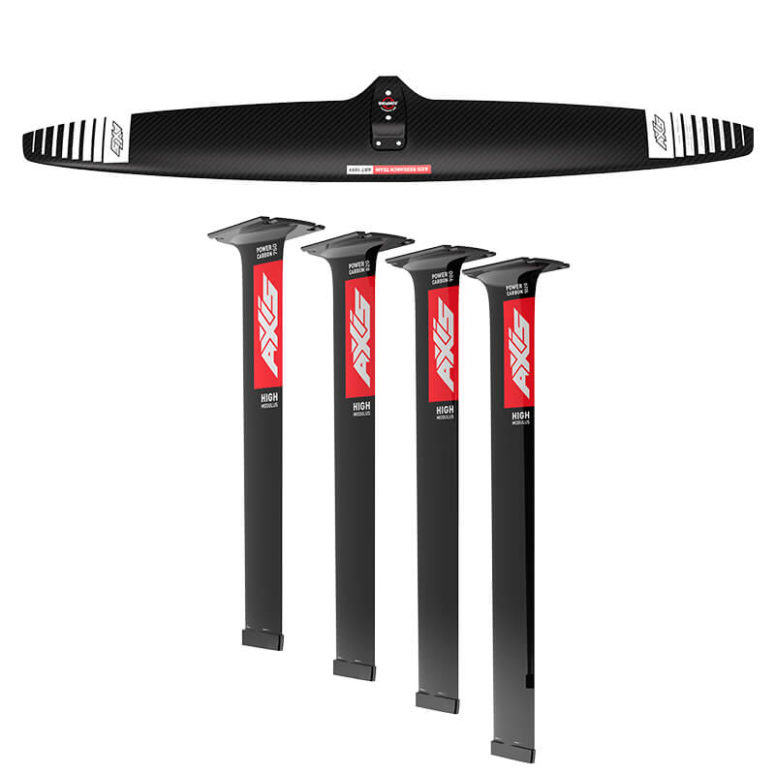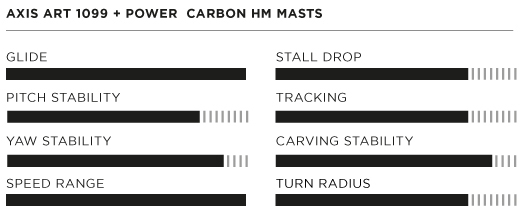

When you purchase gear through links on our site, we may earn a small commission. Here’s why you can trust our tests and our affiliate partner.

AXIS are never afraid to push the boundaries when it comes to range-topping larger sizes, with their rock-solid front plate connection enabling some massive spans with decent control. The ART 1099 (named from its span measurement in mm) is the largest size currently available in the Axis Research Team series, with the smaller sizes being extremely well received across disciplines from both wave and wind propelled riders alike. The wing packs some stats that sit at the upper echelons of the current swathe of high-aspect performance foils, with an aspect ratio of 10.6 and a projected area of 1144cm2. In the sensibly squared tips of the ART series there’s a subtle twist in the tips to soften stall characteristics.
Compatibility-wise, the 1099 slots onto the Black fuselage, and we tested the Ultrashort and Crazyshort versions which we feel is where you’ll get the most from this foil with such a span, and maximizing mobility for the bulk of applications. From our experimentation across the AXIS tail range, the ART 1099 seems to pair best with the 375 and 400 progressive stabilizers. Like many high-aspect foils, across all disciplines it seems to prefer a board with a forward box position to feel balanced and enhance the turning mobility. Due to the innate stiffness in the AXIS system, there’s very little delay when initiating turns in the roll axis. You still need to pre-empt your turns more than with the smaller siblings.
If wingfoiling, there is a very clear no-jumps policy with the 1099, as its thin profile and expansive span isn’t designed to take the impacts, but once you ride it, it’s very obvious that jumping isn’t really what this foil is about. The lightwind performance for a rider with good pumping technique is extremely impressive. Even at 90kg, we could bounce the foil out in sub ten knot conditions with a fast planing board paired with a 5.5m wing. You can then enjoy the ridiculous levels of speed and low friction glide. The way the foil carries speed into tacks, combined with its predictability characteristics opens up fast and graceful maneuvers, and provides a huge amount of entertainment in light wind and smaller wave conditions which could previously be a little tedious. The extra speed you can carry helps your wing support itself when flagged in lighter airs. Its top end speed with a wing is impressive, and much like its smaller siblings, the 1099 scythes through the water with a ghost-like efficiency.
A wing of this size reaches well into SUP foiling; once take-off speed is reached, it pops you onto the foil a little more assertively than the comparable HPS 1050 from our back-to-back testing. It absolutely thrives in glassy water states and manifests a combination of speed and glide that we’ve not really experienced before in this discipline. In aerated and turbulent water states, it can feel a little more sensitive. It handles a tip breach well, so well in fact you may not even realize you’ve extended through the surface. The pumping ability seems to suit a big board, and it gave us a superhuman extension to our range, maintaining momentum well and easily linking waves without having to drop a paddle in. With a span of over a meter, you’d be forgiven for assuming its turning ability would feel like a compromise, but this couldn’t be further from the case.
It’s impossible to mention the 1099 without considering its application to the fast developing discipline of downwinding, particularly with James Casey recently smashing out an impressive and world record breaking 213km voyage along the east coast of Australia. In terms of glide and pump ability, it’s hard to argue with that achievement on completely stock Axis gear.
To get the most from the 1099, you need to be controlled in your body movements and it forces you to adopt an elegant and effortless riding style regardless of discipline. It’s a case of less is more to unlock this high efficiency tool which anyone intermediate level and above should definitely consider as part of their quiver.
We were also lucky enough to get our hands on some pre-release samples of the all-new high-modulus Power Carbon masts in 900mm and 820mm. These have a relatively deep chord, and display some of the most controlled flex characteristics we’ve seen across the market currently. The mast foot to fuselage connection has been completely redesigned with a far more full insert into the fuselage, eliminating all movement at this junction with some tiny tolerances. The mast retains chord over its span with a very gentle taper from around 140mm at the base plate down to 125mm at the foot. They are an absolute gift for heavier riders who found the previous carbon masts a little too springy particularly over the longer lengths. These luxurious offerings provide weight savings over the aluminum, as well as an excellent crisp response, particularly noticeable through pumping and hard carving turns where inputs and feedback to and from the foil are all important. RB
